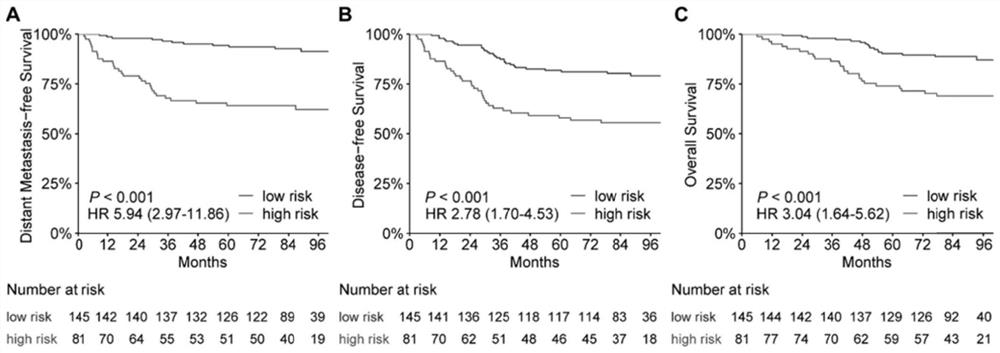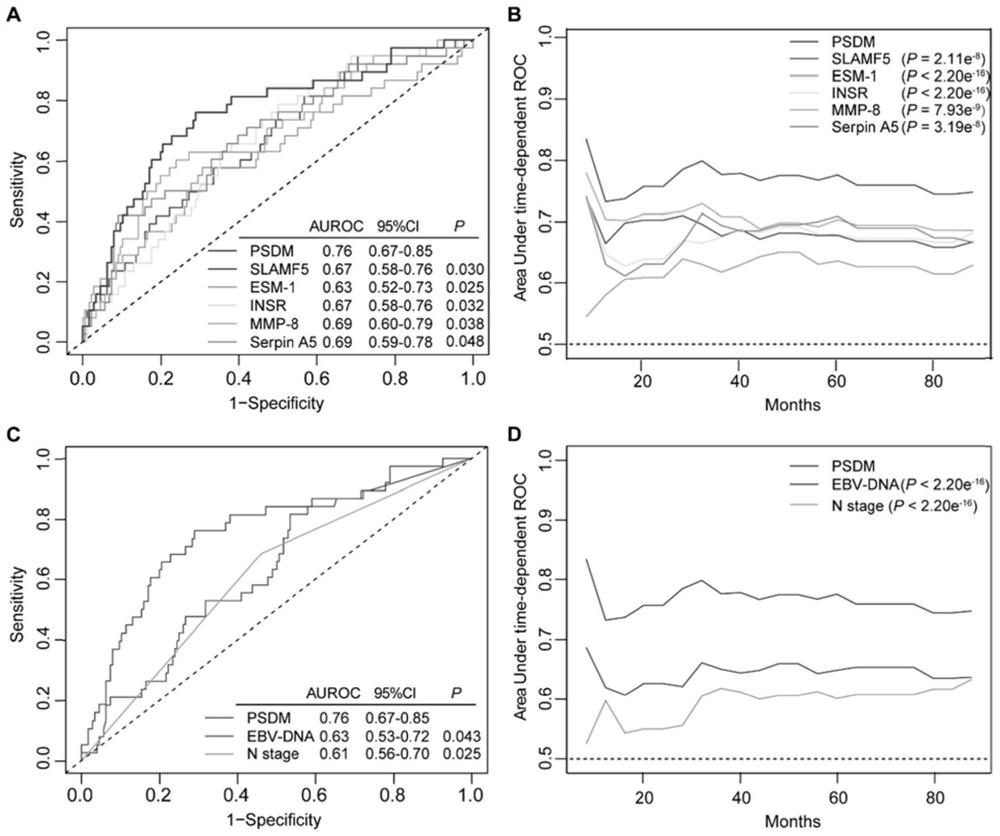A panel of plasma protein markers for predicting the risk of metastasis in nasopharyngeal carcinoma
A marker, nasopharyngeal cancer technology, applied in the field of biomarkers, can solve the problems of differences, inability to completely accurately predict the risk of metastasis and prognosis of patients with nasopharyngeal cancer, and high toxicity and side effects of chemotherapy, so as to achieve good clinical drug use, prediction Metastatic risk and prognostic effects
- Summary
- Abstract
- Description
- Claims
- Application Information
AI Technical Summary
Problems solved by technology
Method used
Image
Examples
Embodiment 1
[0030] Example 1 Screening of markers
[0031] Identification of proteins associated with metastasis-free survival in nasopharyngeal carcinoma:
[0032] The inventors used the customized Raybiotech Quantibody Array protein chip technology platform to detect these 50 differentially expressed genes in 226 specimens, and used univariate Cox analysis to screen out 18 plasma proteins related to the survival of nasopharyngeal carcinoma without distant metastasis.
[0033] Discovery of metastatic protein markers in nasopharyngeal carcinoma:
[0034] The inventor used the LASSO-Cox model to further select five proteins to form a set of markers, including: SLAMF5, ESM-1, MMP-8, INSR, Serpin A5, and named these five protein markers as PSDM (protein-based signature for distant metastasis in LA-NPC, locally advanced nasopharyngeal carcinoma distant metastasis protein signature).
[0035] The scoring formula used by the markers to predict the risk of nasopharyngeal carcinoma metastasis i...
Embodiment 2
[0038] Example 2 Efficacy test of protein markers
[0039] The inventors then compared the efficacy of the combination of protein markers in predicting distant metastasis of nasopharyngeal carcinoma with individual proteins, N stage, and EBV-DNA levels. Time-dependent ROC curves showed that the protein marker combination was more potent than each individual protein at the 5-year time point (C-index: 0.76, 95% CI 0.67-0.85; P image 3 A), while the time-dependent AUC analysis showed that the combined efficacy of protein markers was always better than that of each individual protein over a continuous 7-year time span (P image 3 B). Similarly, we also found that protein markers were better than N stage and pre-treatment EBV-DNA levels in predicting NPC metastasis at 5-year time points and continuous time points (P image 3 C-D).
[0040] In addition, the inventors also analyzed whether DMGN can predict the benefit of induction chemotherapy with docetaxel + cisplatin + 5-fluorour...
PUM
 Login to View More
Login to View More Abstract
Description
Claims
Application Information
 Login to View More
Login to View More - R&D
- Intellectual Property
- Life Sciences
- Materials
- Tech Scout
- Unparalleled Data Quality
- Higher Quality Content
- 60% Fewer Hallucinations
Browse by: Latest US Patents, China's latest patents, Technical Efficacy Thesaurus, Application Domain, Technology Topic, Popular Technical Reports.
© 2025 PatSnap. All rights reserved.Legal|Privacy policy|Modern Slavery Act Transparency Statement|Sitemap|About US| Contact US: help@patsnap.com



